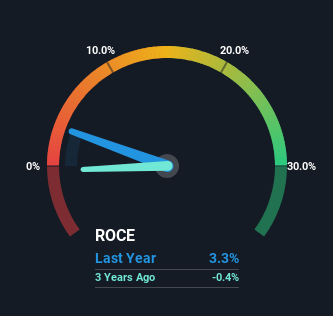- Australia
- /
- Hospitality
- /
- ASX:AGI
Some Investors May Be Worried About Ainsworth Game Technology's (ASX:AGI) Returns On Capital
When we're researching a company, it's sometimes hard to find the warning signs, but there are some financial metrics that can help spot trouble early. Businesses in decline often have two underlying trends, firstly, a declining return on capital employed (ROCE) and a declining base of capital employed. Basically the company is earning less on its investments and it is also reducing its total assets. On that note, looking into Ainsworth Game Technology (ASX:AGI), we weren't too upbeat about how things were going.
Return On Capital Employed (ROCE): What Is It?
If you haven't worked with ROCE before, it measures the 'return' (pre-tax profit) a company generates from capital employed in its business. To calculate this metric for Ainsworth Game Technology, this is the formula:
Return on Capital Employed = Earnings Before Interest and Tax (EBIT) ÷ (Total Assets - Current Liabilities)
0.033 = AU$11m ÷ (AU$426m - AU$93m) (Based on the trailing twelve months to December 2022).
Thus, Ainsworth Game Technology has an ROCE of 3.3%. Ultimately, that's a low return and it under-performs the Hospitality industry average of 6.2%.
View our latest analysis for Ainsworth Game Technology

Above you can see how the current ROCE for Ainsworth Game Technology compares to its prior returns on capital, but there's only so much you can tell from the past. If you'd like, you can check out the forecasts from the analysts covering Ainsworth Game Technology here for free.
The Trend Of ROCE
We are a bit anxious about the trends of ROCE at Ainsworth Game Technology. The company used to generate 13% on its capital five years ago but it has since fallen noticeably. In addition to that, Ainsworth Game Technology is now employing 21% less capital than it was five years ago. When you see both ROCE and capital employed diminishing, it can often be a sign of a mature and shrinking business that might be in structural decline. Typically businesses that exhibit these characteristics aren't the ones that tend to multiply over the long term, because statistically speaking, they've already gone through the growth phase of their life cycle.
While on the subject, we noticed that the ratio of current liabilities to total assets has risen to 22%, which has impacted the ROCE. If current liabilities hadn't increased as much as they did, the ROCE could actually be even lower. While the ratio isn't currently too high, it's worth keeping an eye on this because if it gets particularly high, the business could then face some new elements of risk.
The Bottom Line
In short, lower returns and decreasing amounts capital employed in the business doesn't fill us with confidence. In spite of that, the stock has delivered a 24% return to shareholders who held over the last five years. Regardless, we don't like the trends as they are and if they persist, we think you might find better investments elsewhere.
One more thing to note, we've identified 2 warning signs with Ainsworth Game Technology and understanding them should be part of your investment process.
For those who like to invest in solid companies, check out this free list of companies with solid balance sheets and high returns on equity.
New: Manage All Your Stock Portfolios in One Place
We've created the ultimate portfolio companion for stock investors, and it's free.
• Connect an unlimited number of Portfolios and see your total in one currency
• Be alerted to new Warning Signs or Risks via email or mobile
• Track the Fair Value of your stocks
Have feedback on this article? Concerned about the content? Get in touch with us directly. Alternatively, email editorial-team (at) simplywallst.com.
This article by Simply Wall St is general in nature. We provide commentary based on historical data and analyst forecasts only using an unbiased methodology and our articles are not intended to be financial advice. It does not constitute a recommendation to buy or sell any stock, and does not take account of your objectives, or your financial situation. We aim to bring you long-term focused analysis driven by fundamental data. Note that our analysis may not factor in the latest price-sensitive company announcements or qualitative material. Simply Wall St has no position in any stocks mentioned.
About ASX:AGI
Ainsworth Game Technology
Designs, develops, manufactures, sells, distributes, and services electronic gaming machines, and other related equipment and services in Australia, North America, Latin America, Europe, New Zealand, South Africa, Asia, and internationally.
Flawless balance sheet and good value.
Similar Companies
Market Insights
Community Narratives



